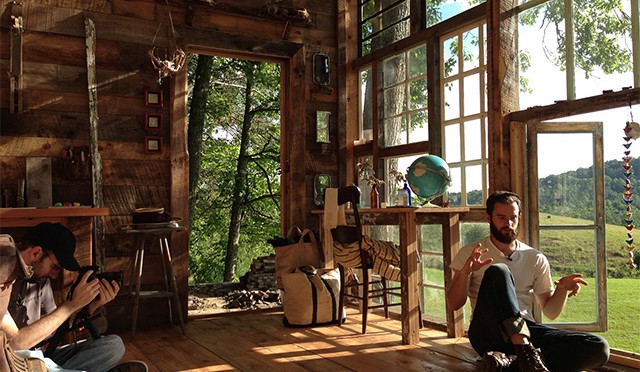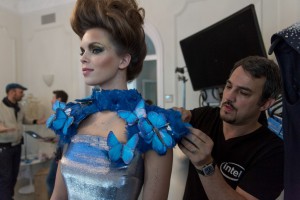Looking into what Vivian and Darryl had brought into this project discussion, particularly “The Butterfly Dress” and the “House Made of Windows”. I chosen these two projects to discuss as they not only tie-in my interests of technology and nature but also the fact that it the project management is carried out with a small group of 2 people.
[Vivian’s The Butterfly Dress Post]
[Darryl’s House Made of Windows]
The Butterfly Dress was crafted by Ezra+Tuba, a fashion design label known for its couture and ready-to-wear apparel. Together with Intel Edison, the designer duo had came up with a wearable technology that allows all 40 butterflies on the dress to be released into the air once people get close enough.
Although the aesthetics are visually stunning, it also brings out the concept to keep people at a distance. We now experience a piece of clothing that not only aesthetically entices the viewer, but enables others to interact with it and serves a function to keeping people at bay. As for the financial aspects of the project, Intel had chipped in to promote and publicize the special dress work creation. In turn, they also gained attention for themselves, promoting their latest module, Intel Edison, that was used for the project.
Now a dress can’t be compared to a house. Can it? The “House Made of Windows” project was conjured by photographer Nick Olson when he had took designer Lilah Horwitz out on their first date in the mountains. They chatted and thought about the possibility of viewing the sunset from any point in a house and jokingly agreed that windows would solve the problem. The pair were hyped about the idea and immediately sourced for the frames from garage sales and antique dealers.
While their project was fairly impromptu and unplanned (they had left their jobs prior to the fabrication), they had amounted their house at an amazing amount of $500 cost! The duo then proceeded to build the home using recycled wood, nails and anything salvageable from an old barn nearby to piece their enormous structure together. It took them months to construct the woodland house in West Virginia, and weeks later to enhance it with antique furniture.
[youtube https://www.youtube.com/watch?v=Fm1PLiR3lcs&w=772&h=315]
[vimeo 70993261 w=500 h=281]
What both projects have done is something extraordinary and intricately detailed: In “The Butterfly Dress”, the garment is made from jacquard and metallic fibers and is embedded with proximity sensors, while “House Made of Windows” designers have to carefully find windows of various sizes to fit into their spatial frame.
However budget constraints exists for “House Made of Windows”, the pair had survived on beans and rice during the construction phase and their roofing was too, salvaged from an abandoned barn.
In the aspect of a long term orientation: Olson and Horwitz from “House Made of Windows” have a plan in mind; to hope build onto the home an outdoor kitchen, solar power and a wood-burning stove. Whereas sisters Ezra and Tuba Çetin’s project was one-off with Intel and have since continued their pursuit on making apparels for couture.



I find this essay talks about more on the project rather than comparing both of them in accordance to Project Management. I feel the selection of both projects is a very daring one as both projects are really different but this could be really interesting if you really compare them. In fact, I can see a similarity in terms of the work they put into the design before executing it. Both projects requires planning in terms of the design and the composition as the execution part is what makes the final product.
Haha, yes @Kamarul I actually overlooked adding on Ramroth’s theory of project management and I would like to briefly mention them here instead of editing the original post (in case it’s been graded already)
Both projects have fulfilled the role of “sole proprietorship”. As the duo are the bosses of their own work. To also focus on their constraints, the “House made of Windows” undoubtedly has to take into account planning for fitting the windows into a frame while “Butterfly Dress” is fixed upon a piece of garment. Additionally, as these projects are rather unique and small-scale, it did not encouraged the project manager to approach iterative design. Instead, we delve straight to the linear production. This is actually against what Ramroth mentions about moving from the “iterative to the linear” in most designer projects (pg 195).
Of course, we still touch upon the 5 phases of project management “start, plan, design, execute, close”. Which I hoped to had covered them in my post earlier. 🙂
And Yes! Projects like these may have an unpredictable result despite careful planning so you do have a good point in mentioning that the final execution counts!
It’s a good succinct summing-up of both works. I am guessing, but could it be that you chose these two projects because both of them refer to something which is ‘external façade’ (either a house or a person’s clothes), and thus they are about finding ways to construct, embellish, and adorn the thin layer that separates someone ‘inside’ (inside the house, inside the clothes) from the environment? Could you develop this further? Or if you think I’m guessing all wrong, explain why, or what the parallels between the two chosen projects might be?
Hi Prof! I chose these two projects because I considered about the literal ‘nature’ of them, being able to build/craft new forms of what we would normally see as mundane (window, dress … butterflies). The project managers had a new perspective of such things and through good handling, executed the project in their favour.
‘External facade’ is also an interesting phrase to fit under the projects.
Though a part of me still thinks that the term applies more to living things, with the cover-up illusion of their image and pride on the outside while internally they are someone different. People can also say, “Do not judge a book by its cover” where the book is “non-living”. Why would people judge non-living things when it’s owned by the living? Nonetheless I shouldn’t ramble on about that.
I agree that having the facade helps not only to separate yourself on the inside but to also define yourself externally to others. In the case of these projects, the “Butterfly Dress” can never be used to describe the person but the wearer is presented as an amazing, stunning figure.
Comparing to a house, people live and breathe in it for longer periods of time than the time interval of wearing clothes, it’s furnished in the same way of however you like it to be. Themes, for example, sets the mood of your personality too. In the case of “House made of Windows”, the designers/project managers adorned their house with antiques, which actually fits their concept of “collection”.
Parallels are straight lines, but they can also go in different direction. While I believe that ‘external facade’ can be one of the common angle, there is also the contrast of other aspects in these projects.
Something I shouldn’t elaborate now because I will be late for class.I really like how you describe them as individual projects, but I also wish you had drawn more parallels between them in relation to project management.
As you mention, the couple had limitations in terms of money and manpower but they also had to make some personal sacrifices during the several months long construction phase. Those sacrifices are difficult to measure or set in relation (or is it even possible?). Anyway, it’s really inspiring to read about people doing such things to fullfil their dreams.
It is really cool what you can do with and how you can integrate today’s technology. Do you know how much it cost to create the dress or the technology behind it? $500 for a house seems a trifling matter, even though they used a lot of recycled materials, in comparison with a high-technology dress. I can only imagine the amount of sensors and the work, such as programming, needed to control 40 butterflies.
Regarding the different phases, I feel that process for “House Made of Windows” is more straight forward and linear. The couple had a lot of limitations to take into considerations. Whilst with the “Butterfly Dress”, the process were more cyclical to get desired behavior of the butterflies. What do you think?
This eassay is good it compares some important elements between the two projects. I think the budget they have really decide and affect what materials and methods they are going to carry out the projects. The high-tech dress is very cool, however, to me, the House is more challengeable. As they still can develop well their project under such budget shortage, well planning is indispensability.